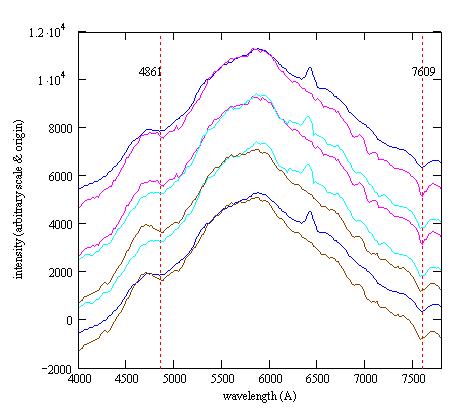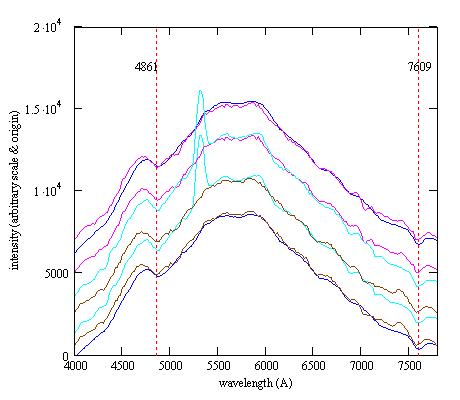SZ Mon: very low resolution spectroscopy (experiment)
Observed: 16, 30 Oct, 24, 28 Dec 2006, 12, 13 Jan 2007
M. Bonnardeau
7 Jun 2007
Revised: 23 Jun 2007 (air mass)
Revised: 26 Jun 2007 (comparison spectrum and control spectrum)
Abstract
I observed this pulsating supergiant with a slitless 100groves/mm transmission grating, trying to see the variations of the spectra as a function of the pulsational phase.
Introduction
SZ Mon is a pulsating yellow supergiant with a 33-day period. I observed it with B,V filters and derived the temperaturature and radius variations.
I complemented these observations with a few very low resolution spectra at different phases of the pulsational cycle. This is only a qualitative experiment to try to see the spectrum variations with the pulsation.
Observations
The observations were carried out with a 203mm SC telescope, a Staranalyzer 100groves/mm transmission grating (with no slit and no collimator), and a ST7E camera (KAF401E CCD). The slit-CCD distance is 52mm yielding a resolution of 17A/pixel.
There are 4 spectra:
| Spectrum number |
Session | Exposition (stackx200s) |
Air mass (mid exposure) |
Phase |
| 2 | 16 Oct 2006 | 12x200 | 1.277 | 0.29 |
| 4 | 28 Dec 2006 | 8x200 | 1.559 | 0.51 |
| 5 | 30 Oct 2006 | 14x200 | 1.278 | 0.72 |
| 6 | 12 Jan 2007 | 10x200 | 1.400 | 0.97 |
(Spectra 1 and 3 do not have the comparison star or the control star rigthly placed).

From top to bottom: Fig 1: the magnitudes as a function of the phase. Red: V filter, Blue: B filter. 2,4,5,6 are the phase positions of the spectra;
Fig 2: the B-V color variations. The range is about 0.3 mag;
Fig 3: the temperature (computed from the B-V measurements);
Fig 4: the angular diameter (computed from the B, V measurements).
The spectra are calibratedin wavelength from the Hbeta 4861 and O2 7609 lines, as explained HERE.
The spectra are corrected for the atmospheric variations from one session to another by using a "comparison star" which is GSC 4800-01666. The spectrum of this star for session N is normalized so has to have the same maximum intensity as for the spectrum for session 2, and a wavelength dependant correction is computed by dividing the 2 spectra. The spectrum of SZ Mon for session N is then multiplied by this correction.
Except for the correction by a comparison star, the spectra are raw: there are not corrected for the instrumental response and are not calibrated in intensity.
A few arcseconds East to SZ Mon there is a fairly bright star (B=12.48 V=12.12). The spectra include the contribution from this nearby star.
I also use a "control star" which is GSC 4800-02229. Its spectra are processed the same way as those of SZ Mon and, as this is a constant star, I expect all of them to be alike.
Results
The 4 spectra are normalized such that the maxima are all the same.
There are presented by increasing pulsational phase, and by pairs so that
they can be easily compared:

Blue: spectrum 2 (phase 0.29). The "line"
near 6400A is a background star overlaped with the slitless spectrum;
Magenta: spectrum 4 (phase 0.51);
Cyan: spectrum 5 (phase 0.72). The "line"
near 6400A is a background star;
Brown: spectrum 6 (phase 0.97).
The lines at 4861 and 7609 are the Hbeta and telluric O2 absorption lines
and are used for the wavelength calibrations.
For the control star:

The line near 5300 for the spectrum 5 (cyan)
is due to a background star.
Conclusions
Technical notes
Telescope and camera configuration.
Computer and software configuration.
Spectroscopy with a StarAnalyzer.
|
|
|||
|
|||
|
|
|||
|
|
|||
|
|||
